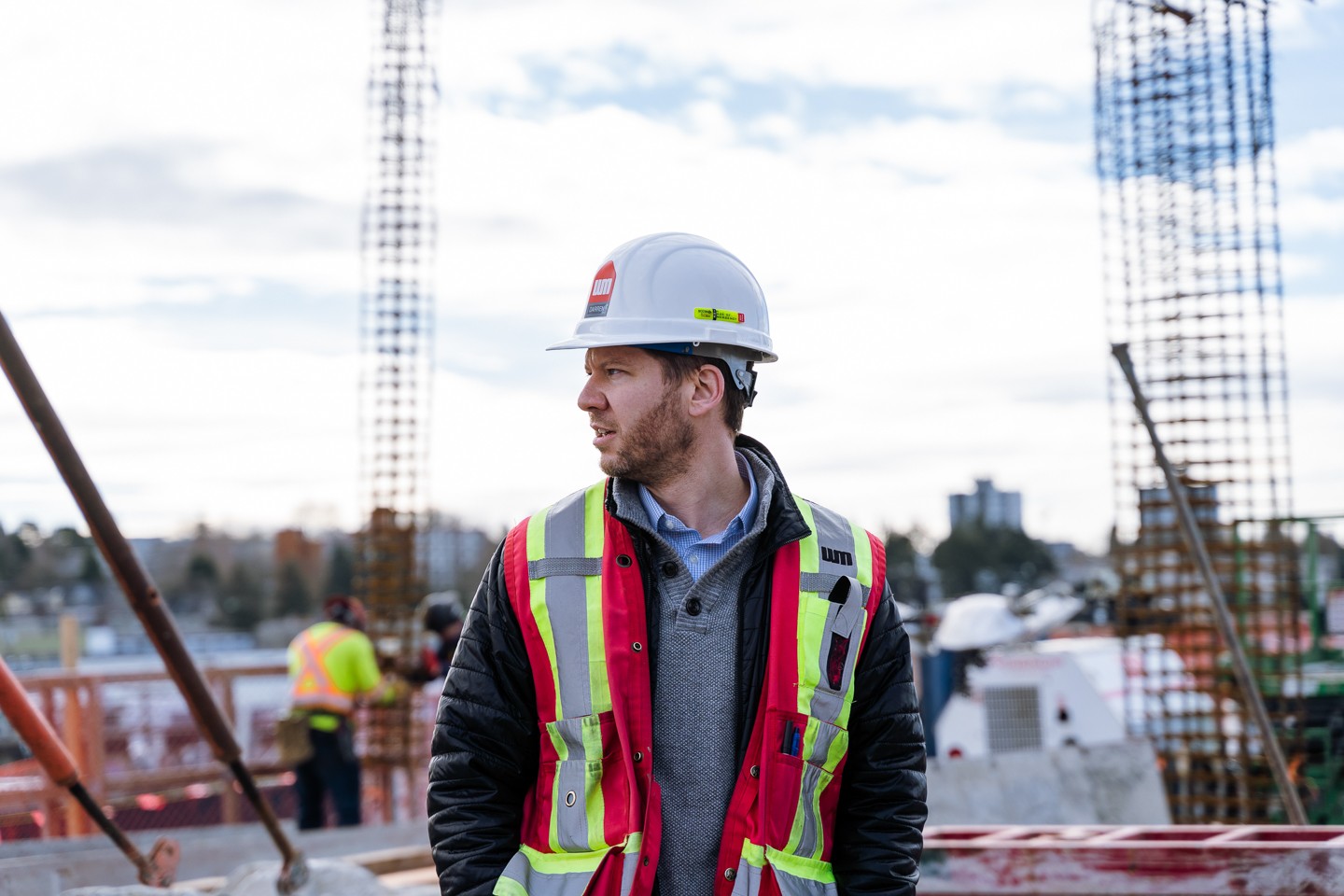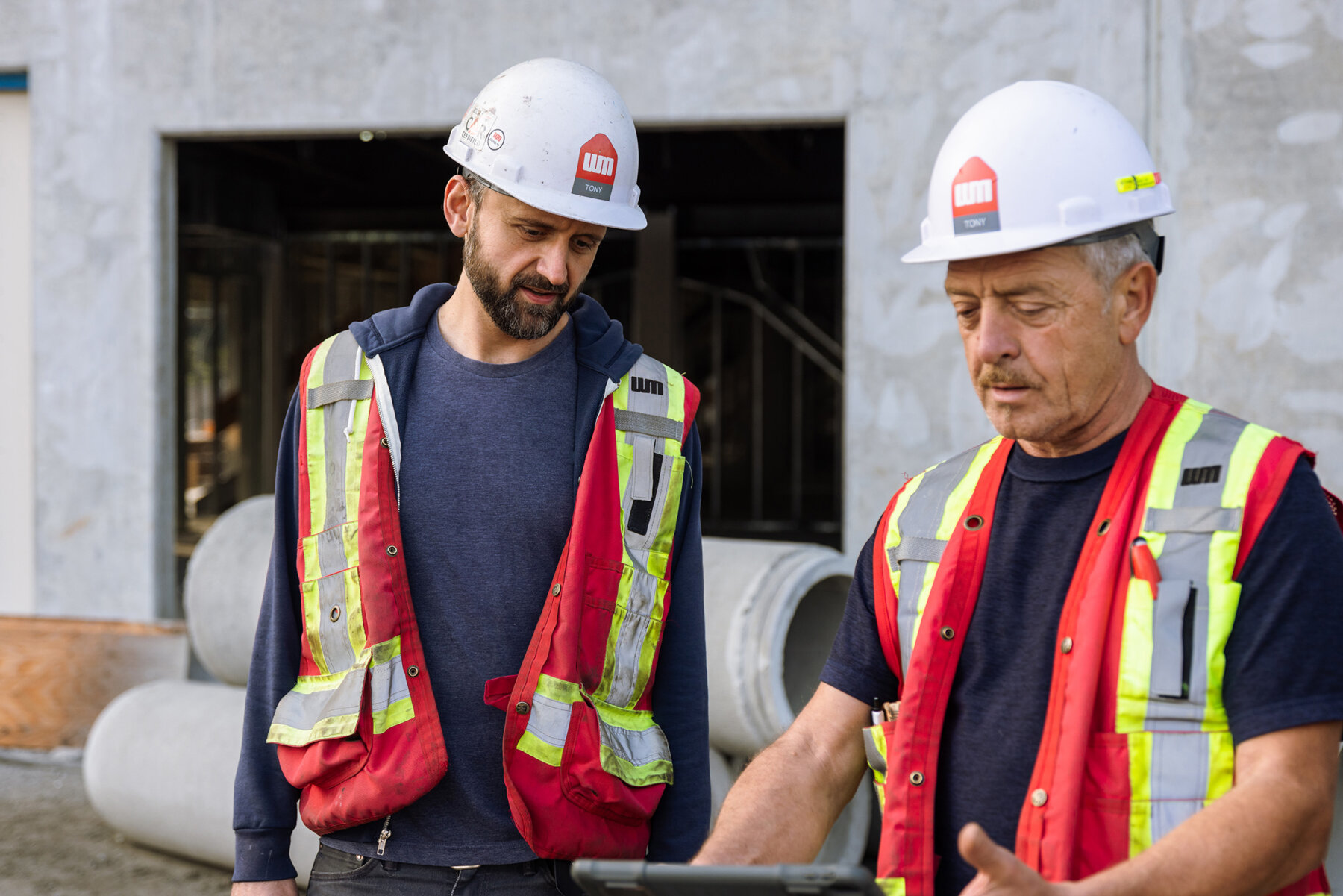Wales offers insight into state of construction innovation
From reflective roofs to low-carbon concrete, Wales McLelland has its eye on construction’s next big technologies and techniques.

Darren Sauer, director of development for Wales McLelland, walks through a job site.
It’s clear that some industry innovation is needed to to hit sustainability goals, overcome labour shortages and address cost challenges. But will that change come rapidly and disrupt the sector? Or will it be a more gradual process?
Darren Sauer, director of development at Wales McLelland, gave his thoughts on the state of industrial and commercial work in Western Canada where Wales works exclusively doing commercial and industrial projects.
He believes innovation is moving at a manageable pace, thanks to the regulatory environment, maturity of the construction sector and the conservative nature of the industry.
“Overall the construction industry is pretty conservative,” said Sauer. “These are huge capital outlays. Like other industries, you’ll get some early adopters for business or marketing reasons. They will be able to absorb the long payback or the upfront capital. We are constantly analyzing things like mass timber, solar panels, electrification and we aren’t seeing any of it on a mass scale yet.”
Sauer said this means there is time for companies to adjust as different technologies and methods are being proven in the field.
He explained that Wales believes builders will see incremental change occurring where use cases are tested on select projects, lessons learned are gleaned, and actual ROI is quantified and understood before wider industry adoption. The following are some technologies and methods that show promise for wider adoption in the future.

Some electrical innovations now standard
Things like LED lighting, integrated lighting controls and occupancy sensors that used to be considered innovative are now becoming ubiquitous thanks to the adoption of American Society of Heating, Refrigerating and Air-Conditioning Engineers (ASHRAE) standards.
“These things were cutting edge 10 to 15 years ago,” said Sauer. “They were extremely expensive and nobody was doing it in warehouses. But the cost came down significantly and with stricter ASHRAE codes they became spec. All had plenty of time to understand it and make it standard. There isn’t a new building now that isn’t LED.”
However this still isn’t the case for solar panels, which remain expensive. But Sauer said he is seeing some clients anticipating the future of electric vehicles by installing underground conduit for future charge station upgrades.
Mechanical systems get more efficient
Mechanical systems have seen a similar trajectory. As energy bylaws are changing with ASHRAE, manufacturers continue to upgrade and improve the efficiency of mechanical units. As a result, units are much more efficient than they were five years ago. Sauer explained that reducing energy consumption continues to be the main focus of sustainable initiatives in mechanical systems. For example, suppliers are able to provide the same amount of air flow but now with less horsepower on the motor with little added cost.
“In Vancouver in particular, the bylaws are almost mandating you go all electric,” said Sauer. “In multi-storey it certainly makes a lot of sense to use all electric mechanical systems, heat pumps and VFV refrigeration systems. Again, we are seeing that technology potentially being applied to larger scale industrial projects like warehousing and distribution. But there is a huge capital premium up front so you really have to run analysis on the payback to see if that makes sense.”
Reflective roofs bounce heat away
Wales has seen groups installing white high-albedo TPO roofing in lieu of ballasted EPDM at a premium.
“This is important to industrial developers and users,” said Sauer. “White TPO is a $5 to $7 premium over traditional options so if you have it on a 400,000 square-foot warehouse, that’s a huge premium of over $2 million. But it has a lot of benefits.”
He explained that white reflective roofing reduces the heat island effect by reflecting solar energy away from the building. In theory this also reduces the heat gain on the building during the summer months, reducing cooling load and improving occupant comfort. LEED points are also available with high-albedo roofing.
Sauer added that he is also seeing a shift away from the installation of green roofs as they are proving to be a maintenance issue for users and come with a significant premium. For example, Port Coquitlam rescinded their green roof bylaw several years ago in favour of improved stormwater management practices.

Government tightens stormwater management
Municipalities across the Lower Mainland are mandating stormwater be managed in such a way that limits pre- and post-development flows. Stormwater detention that stores site runoff to a certain design event and releases slowly back into the ground aquifer are now common.
“All the municipalities have mandated pretty high-level requirements which add hundreds of thousands or even millions of dollars to a project,” said Sauer. “This is no longer a new initiative. It’s just being built into the cost and design of projects. It’s something that was considered a premium or an environmental standard that is now just table stakes.”
Concrete innovating to reduce carbon emissions
According to Sauer, many of the more interesting innovations are happening in concrete as efforts to decarbonize the material pick up steam.
Sauer explained that suppliers are looking to reduce their environmental impacts caused by their operations. For example, increasing the amount of Portland limestone cement to concrete mixes reduces the amount of general Portland cement that needs extracting, lowering the overall footprint of the product.
He noted that the global cement producers have either announced net zero commitments or are moving towards making these pledges. Groups with large multi-national client backing have successfully implemented carbon sequestration into concrete through injecting CO2 into the concrete mix at the batch plant.
“The massive, multi-nationals aren’t going to take this transition lying down and they are spending billions to innovate,” said Sauer. “The big suppliers want their own technology and innovation. Each group is pursuing their own better mixes, extraction processes and carbon capture on their plants.”
He believes this could make it difficult for tech companies like CarbonCure to break into established markets like the Lower Mainland.
“Mass timber loves talking about how bad concrete is and how they produce huge amounts of C02 each year,” said Sauer. “But they aren’t sitting idle. They are actively trying to improve their systems and I think that’s a space that’s going to be watched and it will be super interesting.”
Emerging innovations to watch
Sauer offered the following list of project delivery innovations worth keeping an eye on:
- New delivery methods borrowed from manufacturing and software such as Lean and Agile
- BIM and clash detection software
- Virtual Realty
- Document manage software
- Drone surveying
- Artificial Intelligence in Estimating and Project Management (auto quantity takeoffs, machinery and equipment tracking sensors, wearables, etc.)
- Cloud based design and project management collaboration tools
- Cloud based contract management (reviewing and editing contracts, e-signing, automation of
- progress payments)
Sauer noted that this list of material innovations is also worth tracking:
- Use of mass timber for the super-structure (medium term time horizon)
- Use of modular construction (Wales has seen an increase in this delivery method in residential but with little to no use cases as of yet for industrial work)
- Life Cycle Analysis (LCA) of buildings to understand the asset holistically
- Smart Buildings (increased use of data sensors, BAS, internet of things applied to buildings)
